Search results for: 'Bronze a'
-
 Eisenzeitliche Bronzefibel aus dem östlichen Mittelmeerraum
Eisenzeitliche Bronzefibel aus dem östlichen MittelmeerraumGroße und reich verzierte Fibel, ein früher eisenzeitlicher Typ. Die Oberseite ist mit einem komplexen Muster aus Linien und Voluten verziert. Nadel original erhalten und noch beweglich.
Price: on request Eisenzeitliche Bronzefibel aus dem östlichen Mittelmeerraum
Eisenzeitliche Bronzefibel aus dem östlichen MittelmeerraumReich verzierte Bronzefibel. Die Oberseite ist mit einem komplexen Muster aus Linien und Voluten verziert. Nadel original erhalten und noch beweglich.
Price: on request Luristan bronze dagger
Luristan bronze daggerDouble-edged blade of a short dagger from the Luristan region in Ancient Iran.
€480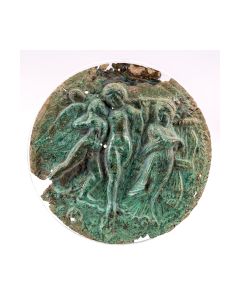 Published Etruscan mirror with Dionysian scene
Published Etruscan mirror with Dionysian sceneSubject of extended scientific analysis, one of only about 34 known specimen. High quality work, excellent condition. Described by Prof. Jucker as "small piece of art". From an old Swiss private collection. Overall in exceptional condition with thoroughly worked details.
Price: on request Neolithic sickle from Northern Germany
Neolithic sickle from Northern GermanySmall crescent-shaped blade made of beautiful polychrome flint. This tool represents an intermediate state within the radical transition from Neolithic to Bronze Age.
Price: on request Neolithic sickle from Denmark
Neolithic sickle from DenmarkCrescent-shaped blade made of beautiful brown flint. This tool represents an intermediate state within the radical transition from Neolithic to Bronze Age.
€700 Neolithic flint sickle from Denmark
Neolithic flint sickle from DenmarkCrescent-shaped blade made of beautiful brown flintstone. This tool represents an intermediate state within the radical transition from Neolithic to Bronze Age.
€530 Neolithic flint sickle from Denmark
Neolithic flint sickle from DenmarkCrescent-shaped blade made of beautiful reddish-brown flintstone. This tool represents an intermediate state within the radical transition from Neolithic to Bronze Age.
€520 Sumerian foundation cone from Uruk
Sumerian foundation cone from UrukSmall conoid clay nail with cuneiform inscription. From the main temple of Uruk, that is also mentioned in the Epos of Gilgamesh. Circa 3rd Millenium BC.
Price: on request Four Scythian arrow heads
Four Scythian arrow headsGroup of four arrowheads made of bronze in excellent condition. Popular weapon of the cultures of the 1st Millennium BC.
€240 Four Scythian arrow heads
Four Scythian arrow headsGroup of four arrowheads made of bronze in excellent condition. Popular weapon of the cultures of the 1st Millennium BC.
€240 Anglo-Saxon bow brooch
Anglo-Saxon bow broochA find from the Isle of Wight from the Migration Period. Beautiful testimonial of the settlement of Britain by the Anglo-Saxons.
Price: on request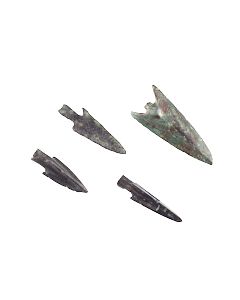 Four Scythian arrow heads
Four Scythian arrow headsGroup of four arrowheads made of bronze in excellent condition. Popular weapon of the cultures of the 1st Millennium BC.
€240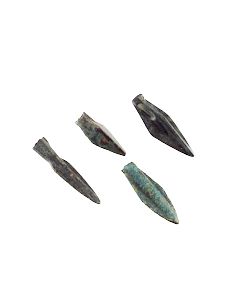 Four Scythian arrow heads
Four Scythian arrow headsGroup of four arrowheads made of bronze in excellent condition. Popular weapon of the cultures of the 1st Millennium BC.
€240 Early Etruscan sanguisuga fibula
Early Etruscan sanguisuga fibulaThe early Etruscan bronze brooch is characterized by its artistically decorated bow. From the collection of Professor Alder-Kissling.
Price: on request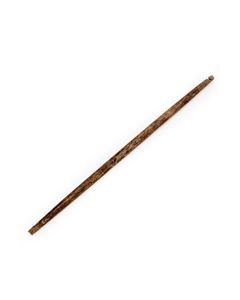 Egyptian spindle shaft made of wood
Egyptian spindle shaft made of woodExceptionally rare main piece of a hand spindle. A find from Thebes in Upper Egypt. From the reign of pharao Senusret II, around 1840 BC.
Price: on request Villanovan fibula from the Hattatt collection
Villanovan fibula from the Hattatt collectionBronze brooch of the Italic Iron Age. The piece is published in the standard work "Brooches of Antiquity".
Price: on request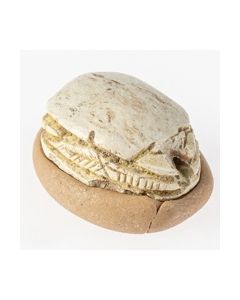 Canaanite scarab
Canaanite scarabLocal levantine production during the 13th to 15th dynasty of Egypt. With an export permit from the Israel Antiquities Authority.
Price: on request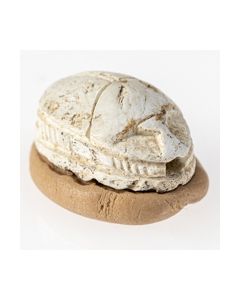 Canaanite scarab with pseudo hieroglyphs
Canaanite scarab with pseudo hieroglyphsThe scarab amulet was made during the Second Intermediate Period of Egypt or slightly later in Canaan. It has pseudo hieroglyphs on the bottom side.
Price: on request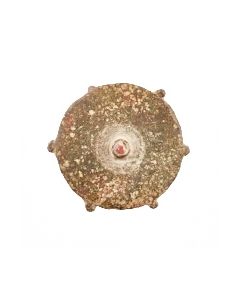 Roman plate brooch found at the Limes
Roman plate brooch found at the LimesAncient brooch with circular plate. Found near the Limes fortifications Pfoerring and Eining in Germany.
Price: on request Large Villanovan fibula from the Hattatt collection
Large Villanovan fibula from the Hattatt collectionImposing bronze brooch of the Italic Iron Age. The piece is published in the standard work "Brooches of Antiquity".
Price: on request Brooch from Roman Britain
Brooch from Roman BritainThis rare variant of the T-shaped brooches was found in Lechlade, Gloucestershire. It dates to the 1st or 2nd century AR. From the famous Hattatt collection and published in two standard works for ancient fibulae.
Price: on request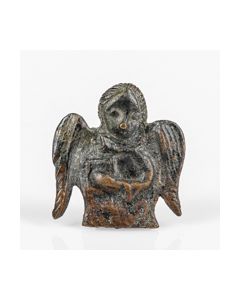 Published coptic bronze figurine of an angel
Published coptic bronze figurine of an angelBetween 1963 and 2009 on exhibition in Vienna, Zurich, Basel and Clermont-Ferrand. Reported to have been found in Middle Egypt. From the famous Prof. Maurice Bouvier collection, acquired in Egypt between 1929 and 1959.
Price: on request Coptic bronze figurine of an angel
Coptic bronze figurine of an angelFrom the famous Prof. Maurice Bouvier collection, acquired in Egypt between 1929 and 1959.
Price: on request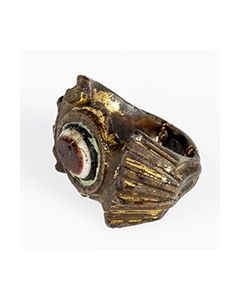 Roman finger ring with imitated agate
Roman finger ring with imitated agateMassive gold plated finger ring dating to the Late Roman Imperial period. The ring impresses with a particularly nice multi-layer glass gem in red, white and black.
Price: on request Four Scythian arrow heads
Four Scythian arrow headsGroup of four arrowheads made of bronze in excellent condition. Popular weapon of the cultures of the 1st Millennium BC.
Price: on request Stone beaker of the Jiroft culture
Stone beaker of the Jiroft cultureHigh quality chlorite vessel from the Kerman province in Iran. From the 3rd millennium BC.
€3,610 Bogenfibel aus dem westlichen Kleinasien
Bogenfibel aus dem westlichen KleinasienFibel mit wunderbarer türkis-grüner Patina. Geschwollener Bügel mit Zierplatte. Sehr seltener Fibeltyp. Etwa 8. Jh. v. Chr. bis 6. Jh. v. Chr.
Price: on request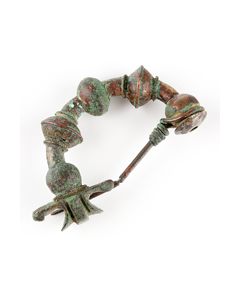 Zentralanatolische Bogenfibel
Zentralanatolische BogenfibelBügel mit fünf kugelartige Zierkörper. Die Nadel ist mit einer Wickelung am Fußende befestigt. 7. bis 6. Jh. v. Chr.
Price: on request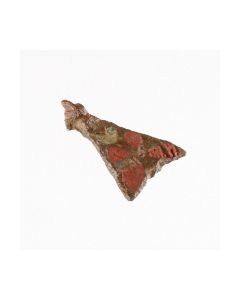 Roman cicada brooch
Roman cicada broochBrooch in the shape of an insect. Popular type in the northern Roman provinces during the 2nd century.
Price: on request Dolphin brooch from Roman Britain
Dolphin brooch from Roman BritainThe so-called dolphin brooch is very British. This specimen was probably made by the Celtic Corieltauvi tribe, shortly after the arrival of the Romans in the middle of the 1st century. Published in two works by Richard Hattatt.
Price: on request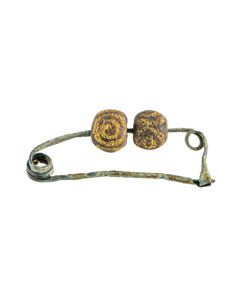 Early Italic brooch decorated with beads
Early Italic brooch decorated with beadsThere rare brooch type from northern Italy is based on predecessors from Greece. The piece is from the famous Richard Hattatt collection and is published in two of his works.
Price: on request Conoid stamp seal
Conoid stamp sealMade from beautiful mottled stone during Iron Age II. The seal is from southern Anatolia or northern Syria and is engraved with a religious scene.
Price: on request Roman wall painting
Roman wall paintingThe fresco shows a young man in full military gear. Interpretations include Mars, the god of war, and Brutus, the murderer of Caesar. The impressive piece is an absolute rarity in its outstanding condition and quality.
Price: on request Villanovan fibula from the Hattatt collection
Villanovan fibula from the Hattatt collectionSerpentine bronze brooch of the Italic Iron Age. The piece is published in the standard work "Brooches of Antiquity".
Price: on request Celtic brooch from Iberia
Celtic brooch from IberiaThe early Celtic brooch dates from the 6th century BC and was found in Spain. This specimen is published in two standard works on ancient brooches.
Price: on request

